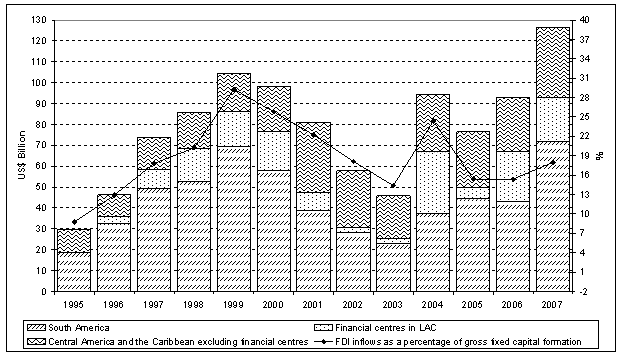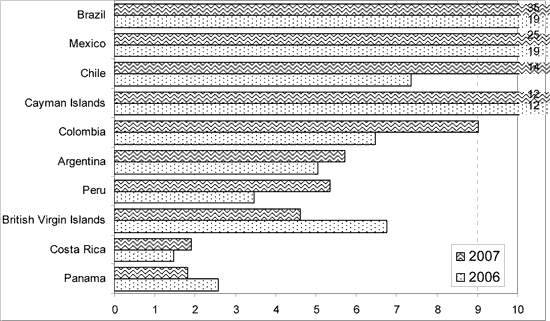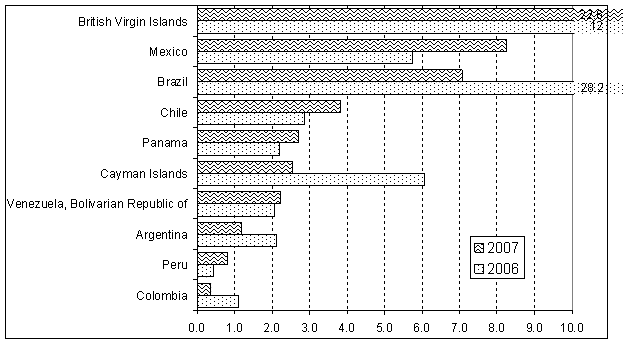| EMBARGO The contents of this press release and the related Report must not be quoted or summarized in the print, broadcast or electronic media before 24 September 2008, 17:00 GMT (13:00 New York, 19:00 Geneva, 22:30 New Delhi, 02:00 - 25 September in Tokyo) |
Geneva, 24 September 2008 - Foreign direct investment (FDI) inflows into Latin America and the Caribbean (LAC) rose by 36% to US$ 126 billion in 2007 (figure 1), according to UNCTAD´s World Investment Report 2008 (1). The highest growth was noted in South America, where investors have been attracted by higher returns and improved macroeconomic performance stemming from higher commodity and oil prices. FDI outflows from Latin America and the Caribbean fell by 17% to US$ 52 billion, largely due to a marked decline in outflows from Brazil.
The 2008 edition of UNCTAD´s annual investment survey is subtitled "Transnational Corporations and the Infrastructure Challenge". The report was released today.
With inward investments of US$ 35 billion, Brazil accounted for a large share of the rise in FDI in the region. It was the leading recipient in 2007, followed by Mexico and Chile (figure 2). In terms of subregional distribution of inward FDI, South America registered the highest average growth rate (over 66%), amounting to US$ 72 billion. There were significant increases in all the major recipient countries (figure 2). In Central America and the Caribbean (excluding the offshore financial centres), the rise was largely due to the 28% increase registered in Mexico, which continued to attract the most inflows in the subregion (73% in 2007). FDI flows to this subregion have displayed resilience in the face of the economic slowdown that began in the United States in the second half of 2007. The report says that is largely because of continuing interest among foreign investors in natural-resource-based activities and the financial services industry.
Metal mining, extractive industries and natural-resource-based manufacturing activities saw the strongest sectoral increases in FDI, whereas high oil prices had a mixed effect. FDI fell in the most richly endowed oil-producing countries, where State-owned enterprises are increasingly dominant, and rose in those countries with declining reserves that tend to promote FDI in oil exploration. In the automotive industry, foreign carmakers increased investments in their Latin American production units, which have a competitive advantage in making small, low-cost cars and those that use alternative fuels, demand for which is booming worldwide. In Central America, FDI in assembly activities was affected by the slowdown in the United States economy. Finally, in the services sector, foreign investors in South America are facing mounting competition from local firms in industries such as electricity and telecoms.
Policy measures related to FDI in Latin America and the Caribbean varied. Some discouraged FDI while others served to improve investment climates. The less favourable policies ranged from reducing incentives and increasing taxes to restricting or prohibiting FDI. While such changes remained concentrated in the extractive industries, they have progressively been extended to other "strategic" industries, including infrastructure in Bolivia and the Bolivarian Republic of Venezuela, and to the food sector in the Bolivarian Republic of Venezuela. In addition, Bolivia, the Bolivarian Republic of Venezuela, Ecuador, and Nicaragua have denounced or are considering denouncing or renegotiating the ICSID Convention (Convention of the International Centre for Settlement of Investment Disputes) and existing bilateral investment treaties. Other LAC countries such as Colombia, El Salvador, and Jamaica, on the other hand, took steps in 2007 to improve their business environments and attract more FDI.
FDI outflows from the LAC fell by 17% in 2007, to US$ 52 billion. This fall was not caused by a slowdown in the internationalization efforts of LAC companies; rather it reflected, in particular, smaller outflows from Brazil (US$ 7 billion) following the exceptionally high outflows in 2006 of US$ 28 billion (figure 3). Latin American companies, mainly from Brazil and Mexico, are now competing for global leadership in such industries as oil and gas, metal mining, cement, steel, and food and beverages. In addition, beyond these traditional industries, new TNCs are emerging, for example in software, petrochemicals and biofuel refining.
The World Investment Report 2008 predicts that inflows to Latin America and the Caribbean will increase in 2008, mainly driven by South America, where high commodity prices and strong economic growth will continue to sustain transnational corporation (TNC) profits. Central America and the Caribbean, excluding offshore financial centres, are likely to face an uncertain year for FDI inflows due to the slowdown in the United States economy, which is expected to affect investments, particularly in export-oriented manufacturing activities.
The World Investment Report and its database are available online at http://www.unctad.org/wir and http://www.unctad.org/fdistatistics |
ANNEX
Tables and figures
Figure 1. Latin America and the Caribbean: FDI inflows in value and as a percentage of gross fixed capital formation, 1995-2007 
Source: World Investment Report 2008: Transnational Corporations and the infrastructure Challenge
Figure 2. Latin America and the Caribbean: top 10 recipients of FDI inflows, a 2006-2007(Billions of US dollars)
Source: World Investment Report 2008: Transnational Corporations and the infrastructure Challenge
Note: a- Ranked by magnitude of 2007 FDI inflows
Figure 3. Latin America and the Caribbean: top 10 sources of FDI outflows, a 2006-2007(Billions of US dollars)
Source: World Investment Report 2008: Transnational Corporations and the infrastructure Challenge
Note:a- Ranked by magnitude of 2007 FDI outflows



